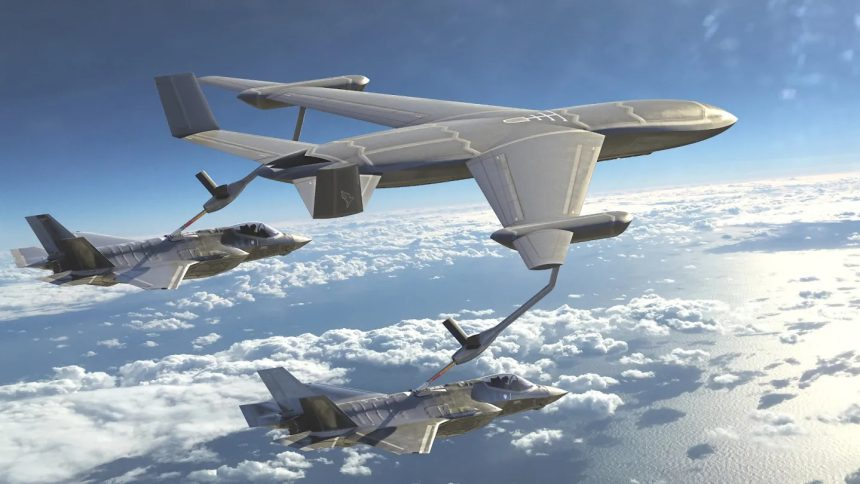


Skunk Works, Lockheed Martin's innovation division, has revealed the first concept images of the KC-Z, a stealth tanker designed to refuel combat aircraft in mid-air intended for the U.S. Air Force’s Next Generation Aerial Refueling System (NGAS).
Published by The War Zone, features from the rendering shows, the concept is about a stealthy, unmanned tanker. The aircraft has a swept wing design, with inclined vertical stabilizers connected to horizontal stabilizers. Although the engine air intakes are unknown, an exhaust outlet for the engine or engines is likely visible at the rear.
Lockheed Martin 's new aerial refueling system has been unveiled as a next-generation solution to support other stealth aircraft. In the images revealed, the KC-Z can be shown refueling two F-35 Lightning II aircraft in the air, demonstrating its ability to operate alongside cutting-edge fighter aircraft.
This aircraft, which can operate both manned and unmanned, will be essential to support stealth aircraft such as the F-35 . The KC-Z is expected to be available between 2030 and 2040.
This development adds to the Air Force 's efforts to modernize its aircraft fleet and explore the option of using unmanned aircraft to carry out refueling tasks.
The KC-Z will gradually replace the KC-46 Pegasus and KC-135 Stratotanker over the coming decades, as part of the Next Generation Air Refueling System (NGAS).
In the early 2000s, the U.S. Air Force began replacing its fleet of aerial refueling tankers, which then consisted of more than 550 KC-10A Extenders, KC-130s and KC-135s.
The mega project was then broken down into three successive programs of 180 aircraft over a decade each, and named KC-X, KC-Y and KC-Z. Following a competition that initially saw the Airbus A330 MRTT selected, Congress put pressure on the final choice to be the Boeing KC-46A Pegasus in 2013.
In 2019, the USAF launched its second program, reduced to 160 aircraft. Here again, the KC-46A Pegasus was opposed to the A330 MRTT of the European Airbus, associated for the occasion with Lockheed Martin.
This aerial refueling program seeks to maintain the United States' air power projection capability, especially in strategic regions such as the Indo-Pacific .
Meanwhile, the Air Force continues to acquire older models to meet its immediate operational needs, such as the recent $2.3 billion contract for 15 KC-46s .
The evolution of the U.S. stealth aircraft fleet is underway through several key programs. The Air Force’s Next Generation Air Dominance (NGAD), for example, seeks to create a sixth-generation fighter aircraft, while the B-21 Raider will strengthen strategic bombing capability.
In addition to these programs, the Navy's F/A-XX program also aims to develop a sixth-generation stealth aircraft capable of operating from aircraft carriers.
Advances in the field of stealth aviation focus on improving aerial refueling capabilities, which is essential to extending the range and autonomy of fighter aircraft.
The stealth capabilities of stealth aircraft, which combine special design and radar signature reduction technologies, represent the future of air combat.
With the development of the KC-Z , the Air Force is well positioned to maximize the potential of its fleet and meet the challenges on the horizon of air warfare. Stealth will be key to the future of air operations, and the investment in the KC-Z underscores this focus.
While the cost of the program may be significant, the capabilities of this stealth tanker will allow the US to maintain its air supremacy in a highly competitive combat environment, with cutting-edge platforms ensuring technological advantage.
However, the recent announcements on the temporary suspension of the NGAD program could have certain consequences on the KC-Y and KC-Z programs, if only through the budgetary arbitrations which are currently being carried out by the US Air Force.
You may like to read.....
